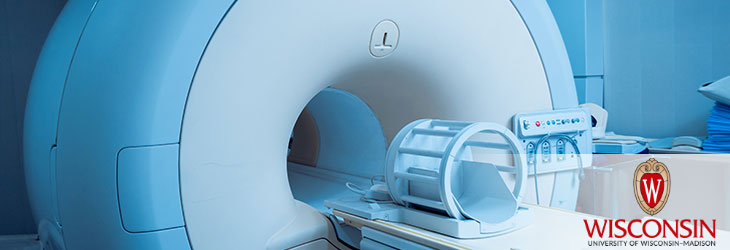Radiation Therapy

Image Reconstruction Method for High Temporal Resolution Image Guided Radiaton Therapy
WARF: P08125US
Inventors: Guang-Hong Chen, Shuai Leng
The Wisconsin Alumni Research Foundation (WARF) is seeking commercial partners interested in developing a medical image reconstruction method for use with time-resolved image-guided radiation therapy (IGRT) as well as other medical imaging techniques.
Overview
Computed tomography (CT) systems are used for medical imaging and produce images by measuring the loss in an X-ray beam’s strength. These measurements are used to reconstruct an image in 2-D or 3-D based on the data collection technique. CT systems often are combined with radiation therapy. This therapy is a treatment technique that delivers radiation to a specific point in the body, such as a tumor, while maintaining a low radiation dose to the surrounding healthy tissue.
Intensity modulation radiation therapy (IMRT) is a technique that uses highly precise computer planning software and CT images to focus high radiation doses in smaller areas. Image-guided radiation therapy (IGRT) is a similar technique that employs CT imaging systems simultaneously with the radiation therapy to improve radiation accuracy and reduce the dose delivered to surrounding healthy tissue. IGRT also may utilize a “four-dimensional” technique that creates a time series of 3-D images to monitor the process during the radiation therapy.
Intensity modulation radiation therapy (IMRT) is a technique that uses highly precise computer planning software and CT images to focus high radiation doses in smaller areas. Image-guided radiation therapy (IGRT) is a similar technique that employs CT imaging systems simultaneously with the radiation therapy to improve radiation accuracy and reduce the dose delivered to surrounding healthy tissue. IGRT also may utilize a “four-dimensional” technique that creates a time series of 3-D images to monitor the process during the radiation therapy.
The Invention
UW–Madison researchers have developed a medical image reconstruction method designed to increase temporal resolution, while increasing accuracy and reducing the radiation dose to the patient. The method may be applicable to numerous imaging techniques including magnetic resonance imaging (MRI), X-ray computed tomography (CT), positron emission tomography (PET) and single photon emission computed tomography (SPECT).
Acquired data is used to reconstruct a “sparsifying image.” A “correction image” is iteratively determined and subtracted from the sparsifying image to produce a quality image.
The technique also can be applied to current IGRT techniques to increase the accuracy of radiation delivery. Sparsifying images are obtained for a specific phase of the respiratory cycle to more accurately determine the motion characteristics of the target tumor and increase the temporal resolution.
Acquired data is used to reconstruct a “sparsifying image.” A “correction image” is iteratively determined and subtracted from the sparsifying image to produce a quality image.
The technique also can be applied to current IGRT techniques to increase the accuracy of radiation delivery. Sparsifying images are obtained for a specific phase of the respiratory cycle to more accurately determine the motion characteristics of the target tumor and increase the temporal resolution.
Applications
- High temporal resolution 4-D cone-beam CT guided radiation therapy
- MRI, X-ray CT, PET and SPECT image reconstruction
Key Benefits
- Eliminates effect of patient’s breathing on imaging
- Reduces scan time
- Reduces radiation dose to patient
- Increases temporal resolution in time-resolved studies
Additional Information
For More Information About the Inventors
Tech Fields
For current licensing status, please contact Jeanine Burmania at [javascript protected email address] or 608-960-9846